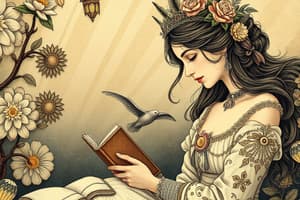Podcast
Questions and Answers
Which of the following is a type of fictional prose?
Which of the following is a type of fictional prose?
- Legends
- Instruction manual
- Novels (correct)
- Newspaper
The climax is the introduction of a story.
The climax is the introduction of a story.
False (B)
What is the purpose of dialogue in a drama?
What is the purpose of dialogue in a drama?
To reveal key details, thoughts, emotions, and motivations of characters.
The __________ is the main character in a story.
The __________ is the main character in a story.
Match the following elements of story structure with their definitions:
Match the following elements of story structure with their definitions:
Which of the following best defines 'Flashback'?
Which of the following best defines 'Flashback'?
The antagonist is the character who resolves the conflict.
The antagonist is the character who resolves the conflict.
What is an example of a theme that authors often explore?
What is an example of a theme that authors often explore?
The __________ involves the arrangement of the script, including dialogue and stage directions.
The __________ involves the arrangement of the script, including dialogue and stage directions.
Which of the following elements contributes to stage direction?
Which of the following elements contributes to stage direction?
Flashcards are hidden until you start studying
Study Notes
Nonfictional Prose
- Portici serves as both factual and oral history documentation.
- Instruction manuals are often conserved through oral traditions.
- Newspapers contribute to the genre but focus primarily on shorter narratives.
- Legends and fables are crafted for oral storytelling, intended to be spoken aloud.
Fictional Prose
- Fiction is birthed from the author's imagination, such as in the example of Shrek.
- Poems are structured to maintain rhyme and rhythm.
- Novels are lengthier fictional narratives that include a cast of characters and often come with a rolling ending for event descriptions.
- Chapters define books through variation in length and stylistic elements.
- Literary styles manifest across genres like romance, mystery, horror, western, science fiction, and fantasy.
- Perspective (POV) varies based on the author's viewpoint.
- Themes undergo extensive exploration and development throughout the narrative.
- Dialogue consists of conversations between characters, enhancing the interaction within the story.
- Linear plots follow a chronological or sequential sequence of events.
- Narratives can be interrupted by flashbacks, highlighting past events.
Key Elements of a Story
- Exposition introduces characters and setting.
- Rising action builds tension that leads to the main conflict.
- Climax marks the turning point, representing the most intense moment of the plot.
- Falling action encompasses events that follow the climax.
- Resolution concludes the story, resolving the primary conflict.
Drama
- Drama is characterized by scripts that prioritize dialogue and narrative.
- Thematic elements such as love, conflict, and tragedy are explored through characters, staging, and emotional truths.
Audience Engagement
- Audience reactions influence the direction and impact of stage plays, contributing to a shared emotional journey.
- The relationship between viewers and actors, as in the example of Lester, forms the crux of dramatic narratives.
Characters in Drama
- Actors infuse life into their roles, revealing character traits through action and spoken dialogue.
- Characters drive the plot forward through their actions, descriptive dialogue, and interactions.
- The protagonist serves as the main character, while the antagonist introduces conflict.
Staging & Stage Direction
- Effective staging incorporates set design, props, lighting, sound, and costumes.
- Actor positioning is essential for guiding the narrative journey.
- Development of staging elements is critical for narrative progression.
- The atmosphere created through staging techniques significantly influences the mood of the production.
- Staging choices enhance the dramatic effect on the audience.
Dialogue in Drama
- Dialogue is a vital tool for revealing thoughts, emotions, motivations, and essential details about characters and plot.
Studying That Suits You
Use AI to generate personalized quizzes and flashcards to suit your learning preferences.




